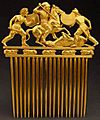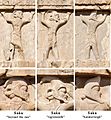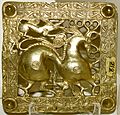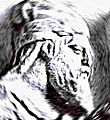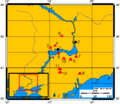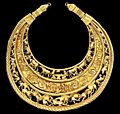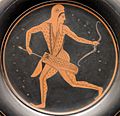Scythians facts for kids
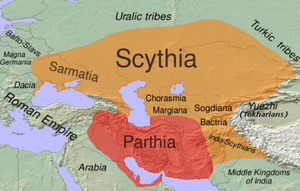
Approximate extent of East Iranian languages the 1st century BC is shown in orange.
|
|
| Total population | |
|---|---|
| Unknown | |
| Regions with significant populations | |
| Eastern Europe Central Asia West Asia Northern India |
|
| Languages | |
| Scythian language | |
| Religion | |
| Animism, Buddhism, Hinduism and Zoroastrianism | |
| Related ethnic groups | |
The Scythians or Scyths were an ancient group of people. They were nomadic, meaning they moved around a lot instead of staying in one place. These people were from Eurasia, a huge landmass that includes Europe and Asia.
The Scythians were very famous for their amazing skills at riding horses. They were so good that they controlled a large area called the Pontic steppe. This region is now parts of modern-day Ukraine and Southern Russia. They were powerful throughout the ancient world. Around the 2nd century AD, another group called the Sarmatians became more powerful than the Scythians in this area.
Learning About the Scythians
Much of what we know about the Scythians comes from a famous Greek historian named Herodotus. He wrote about them around 440 BC in his book, Histories.
We also learn a lot from archaeology. This is the study of old things people left behind. Archaeologists have found beautiful gold items in Scythian kurgans. Kurgans are special burial mounds. These amazing gold treasures have been found in Ukraine and southern Russia.
Scythian Life and Culture
The Scythians were known for their unique culture. Their art often featured animals, showing their close connection to nature and hunting. They were skilled warriors and archers, using special bows called Scythian bows. Their fighting style even influenced other powerful empires like the Persians.
Images for kids
-
Scythian vessel from Voronezh, 4th century BCE. Hermitage Museum.
-
For the Achaemenids, there were three types of Sakas: the Sakā tayai paradraya ("beyond the sea", presumably between the Greeks and the Thracians on the Western side of the Black Sea), the Sakā tigraxaudā ("with pointed caps"), the Sakā haumavargā ("Hauma drinkers", furthest East). Soldiers of the Achaemenid army, Xerxes I tomb detail, circa 480 BCE.
-
Gold Scythian belt title, Mingachevir (ancient Scythian kingdom), Azerbaijan, 7th century BCE
-
The territory of the Scythae Basilaei ("Royal Scyths") along the north shore of the Black Sea around 125 AD
-
Arzhan kurgan in Tuva Republic, southern Siberia, Russia
-
Remains of Scythian Neapolis near modern-day Simferopol, Crimea. It served as a political center of the Scythians in the Late Scythian period.
-
Gold pectoral, or neckpiece, from a royal kurgan in Tovsta Mohyla, Pokrov, Ukraine, dated to the second half of the 4th century BCE, of Greek workmanship. The central lower tier shows three horses, each being torn apart by two griffins. Scythian art was especially focused on animal figures.
-
An Attic vase-painting of a Scythian archer (a police force in Athens) by Epiktetos, 520–500 BCE
-
Scythians at the Tomb of Ovid (c. 1640), by Johann Heinrich Schönfeld
-
Romantic nationalism: Battle between the Scythians and the Slavs (Viktor Vasnetsov, 1881)
-
Eugène Delacroix's painting of the Roman poet, Ovid, in exile among the Scythians
See also
 In Spanish: Pueblos escitas para niños
In Spanish: Pueblos escitas para niños


